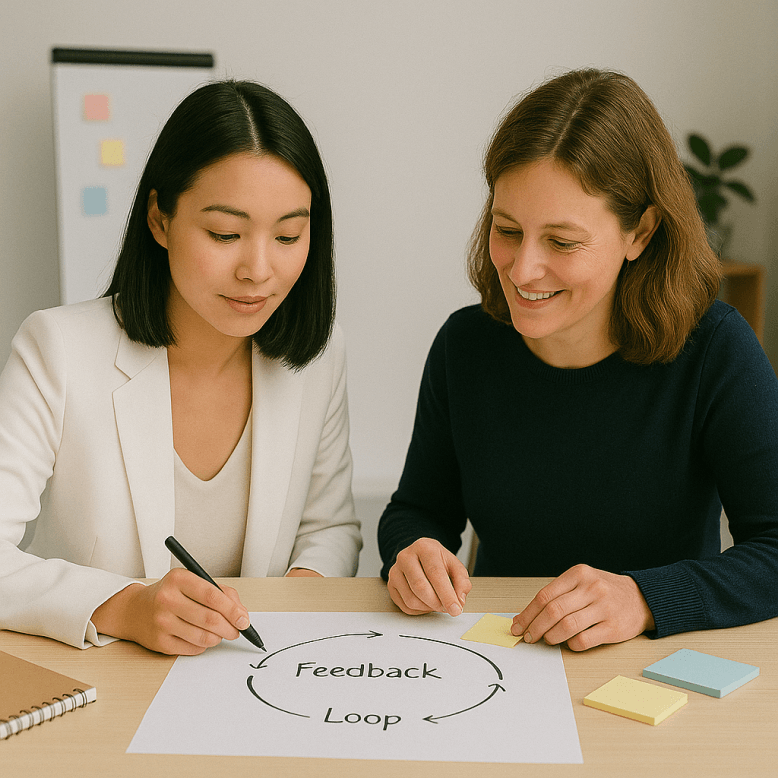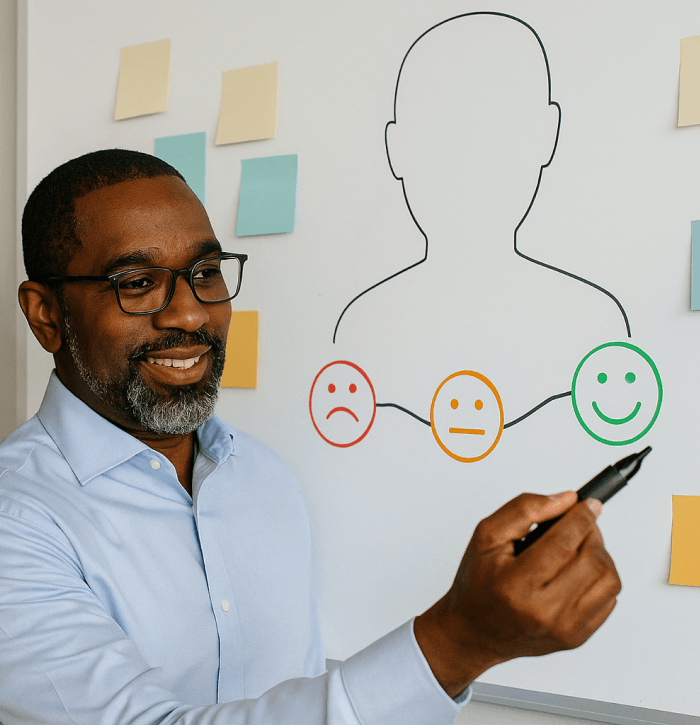Updated: October 11, 2024- 16 min read
Guessing what your customers want can be two things: a recipe for a disaster or a nice start.
If your team is building products based on hunches blended with some earned merits or authority, you’re setting yourself up for frustration. If, on the other hand, you’re assuming and then putting things up for scrutiny, then you’ve got a good chance to consolidate your practice.
Yes, customer discovery — a structured way of stepping outside your office and actually talking to real people who might use your product.
It’s about figuring out what makes them tick, what they find frustrating, and how your product can save the day.
Think of it as your product’s first big reality check—before you invest time and money into something you ‘assumed’ was needed. Let’s dive in!
Free User Persona Template
Get to know your users to build the right solution for the right audience.
Get Yours Now
What Is Customer Discovery?
To walk in the shoes of the customer, you first have to remove your own. Very few people actually remove their own shoes before they try to walk in the shoes of the customer.
— Prashanthi Ravanavarapu, Global Fintech Product Executive at PayPal, on The Product Podcast
Customer discovery is the process of understanding who your customers are, what problems they face, and how your product can solve those problems. It’s all about validating your assumptions before jumping into product development.
By engaging with potential users, gathering their feedback, and digging into their pain points, product teams can make more informed decisions that lead to better products.
Customer Discovery Definition
At the crux, customer discovery is about learning and validation. It's the process of stepping outside your walls, talking to potential customers, and finding out whether the problem you think exists is actually something that bothers them. The goal is to reduce risks, avoid costly mistakes, and develop solutions that people really need.
The customer discovery process became popular through the Lean Startup movement, pioneered by Steve Blank in the early 2000s. Blank emphasized the idea of "getting out of the building" to understand customers. Assumptions, he believed, were only to be tested rather than trusted.
Eric Ries built on this with the Lean Startup framework, which encouraged continuous learning and iteration. This idea fundamentally shifted how companies develop new products, putting the customer at the center of everything.
Customer discovery is a key component of several methodologies, especially those focused on Lean principles and Agile development. Some of the common frameworks include:
Lean Startup: Focuses on building a minimal viable product (MVP), testing it with real users, and iterating based on their feedback. Customer discovery is the first step in this process.
Design Thinking: Starts with empathizing with customers and understanding their needs. Customer discovery fits into the "empathize" and "define" stages, where teams focus on identifying user pain points.
Jobs-to-Be-Done (JTBD): This framework helps teams understand the "job" a customer is trying to get done. Customer discovery involves understanding what customers are really trying to achieve and how your product can fit into their workflow.
Customer Discovery Example
Imagine you're developing an AI tool for SaaS companies. Before writing a single line of code, you’d conduct customer discovery interviews with team leads from different industries. As a result, you could learn that while most teams have product management tools, they struggle with integrating them into their existing workflows.
This insight could shape your product to focus on seamless integrations. Adding more features, which is what your product team initially thought was crucial, would therefore slide down the development pipeline.
Customer discovery is the first step to actually build something people want. Thanks to such an approach you can avoid the trap of developing products based on assumptions alone.
Stages of the Customer Discovery Process
The customer discovery process is typically broken down into four key stages. Each stage helps product teams get closer to understanding their customers.

1. Problem Identification (a.k.a. Problem-Solution Fit)
This stage is all about framing the right problem before you start thinking about solutions. It’s also where you identify whether the problem you think exists actually matters to customers—hence the term "problem-solution fit." If there’s no significant pain point, you risk solving a problem no one cares about.
A great way to start is by answering a few essential questions:
What problem do we believe our target users are facing?
How critical is this problem in their daily workflow?
What’s the impact of not solving this problem?
You’ll often hear product teams call this the “discovery phase.” It’s where you’re doing deep-dive research, not just with customers, but also by examining the market, competitors, and industry trends. The goal is to validate that this problem is worth solving. If you’re chasing a “nice-to-have” instead of a “must-have,” your product could fall flat.
2. Hypothesis Development
Now that you've got a problem to solve, it’s time to create hypotheses — testable assumptions about your customers' behaviors, needs, and preferences. At this point, you’re laying down what you think is true, but still operating in the land of uncertainty.
This stage is sometimes referred to as "getting out of the building", meaning that product teams should avoid the trap of sitting behind desks, guessing what customers want. A well-framed hypothesis could be something like:
“If we reduce the number of steps required in our invoicing software, customers will report faster billing cycles.”
"If we implement a self-service onboarding process, new customers will start using the product within 24 hours without requiring additional support."
"If we offer real-time analytics in our project management tool, team leaders will be able to make quicker decisions, reducing project delays by 15%."
The trick is to keep your hypotheses actionable. A bad hypothesis is vague or too complex to test; a good one is specific and can be proven or disproven. This step is crucial because it's where you shape what you’ll be testing in the next stages. Essentially, this is the blueprint for the customer interviews, which is the phase that comes next.
3. Customer Interviews
This is the heart of customer discovery. Also known as the "voice of the customer" (VoC) stage, it’s all about hearing what customers really think, how they work, and what’s bothering them.
In practice, this means sitting down with users (virtually or in person) and diving into their pain points, workflows, and experiences. A big part of this user research stage is learning how to ask the right questions. Here are a few tips:
Focus on open-ended questions to let customers share their stories.
Avoid leading questions that push them toward a certain answer.
Make them compare other solutions to yours.
Dig deep. Don’t just ask surface-level questions—probe with follow-ups like “Why?” or “Can you tell me more about that?”
In product jargon, you’ll hear a lot about “pattern recognition” at this stage. This refers to spotting trends in the feedback you’re hearing from multiple users. If three out of five customers mention the same frustration, that’s a strong signal you’ve found a genuine problem.
Here are a few types of questions that work best during customer interviews to really uncover valuable insights:
“Can you walk me through your current process?” – This open-ended question helps you understand the customer’s workflow in their own words.
“What’s the biggest challenge you’re facing right now?” – Get straight to the pain points. This question opens the door to discussing their frustrations.
“What have you tried to solve this problem so far?” – This helps you see if they’ve used other solutions or workarounds, revealing market gaps.
“How do you feel about [specific solution]?” – Get feedback on existing tools they’re using or even your product to see where improvements can be made.
“What’s the one thing you wish [solution] could do for you?” – Uncover feature requests or unmet needs that could give you an edge.
“What would happen if this problem weren’t solved?” – This question helps gauge how urgent the problem is for them and can hint at how much they’d be willing to invest in a solution.
4. Solution Validation
Finally, once you’ve gathered all that feedback, it’s time for solution validation. This is where you test whether the solution you’re envisioning actually fits the problem — commonly referred to as Product-Market Fit.
At this stage, you might create a prototype, a proof of concept, or a minimum viable product (MVP). The point is to have a stripped-down version of your product that captures the essential features. The goal is to see if your solution resonates with users before you invest heavily in a full-scale product launch.
Some questions you’re looking to answer:
Does this solution solve the customer’s problem in a meaningful way?
Is the customer willing to pay for this solution?
Are there any gaps between the solution and their expectations?
During validation, you may go back and forth between “iterating” or “pivoting”, of course.
You’ll need to make a lot of small adjustments based on feedback to improve the product, and probably make pivots — changing the entire direction of the product based on what you learned during interviews.
Regardless of the uncomfortable idea of flipping the script by 180° and having hectic sprints, both are to be expected at this stage. In fact, it's the best way to approach the process without causing unnecessary disruption to your team.
Four Approaches to Customer Discovery
Everyone should, in a product role, be spending a lot of time with customers. It's something you should measure and should be part of your success criteria for your team.
— Trisha Price, CPO at Pendo, on The Product Podcast
When it comes to how to do customer discovery, different teams often lean on specific product management frameworks or methods to guide the process. These methods provide structure. They help teams figure out who their customers are, what problems they’re trying to solve, and how their product fits into the picture.
The four primary approaches to customer discovery are Lean Startup, Design Thinking, Jobs-to-Be-Done (JTBD), and the Customer Development Model. Here’s how each ties into customer discovery and how different teams approach them.

1. Lean Startup: Learn Fast, Fail Fast
The Lean Startup method is built on the idea that instead of assuming and then building, you start with the MVP and get feedback as early as possible. This makes customer discovery the cornerstone of the approach.
Customer discovery is the first step in the Lean Startup approach. Before you even think about developing a product, you need to validate whether your idea solves a real customer problem.
Teams do this by conducting interviews, collecting ‘qual and quant’ data, running A/B tests, and building MVPs to test hypotheses. The focus is on quick iterations and constant product learning, so the discovery process doesn’t stop after the first round of feedback. It’s an ongoing cycle of learning, building, and testing.
Product teams using the Lean Startup approach are often flexible, nimble, and ready to pivot quickly. They thrive in environments where speed and adaptability are critical.
A team might start with a simple hypothesis—"Will users find value in this feature?"—and build a basic version of that feature to test with a small group of users. Based on user feedback, they iterate and refine, continuously discovering what customers need and want.
2. Design Thinking: Empathy at the Core
Design Thinking is all about understanding the human side of the problem before jumping into solutions. This method, used by many product design and management teams, encourages a deep dive into users’ emotions, motivations, and pain points. It's often associated with creative, disruptive approaches to problem-solving.
Customer discovery fits into the first two stages of Design Thinking: Empathize and Define.
During the Empathize stage, teams conduct interviews, shadow users, and observe real-life interactions to gain a deep understanding of the customers' needs and pain points. Once they’ve gathered insights, they move to the Define stage, where they frame the problem in a clear, user-centered way.
The goal is not just to confirm assumptions but to uncover needs users might not even be aware of themselves. It’s about gaining empathy, understanding how users feel, and then defining the real problem to solve.
Design teams and product managers who embrace Design Thinking often spend a significant amount of time upfront talking to users. They conduct in-depth interviews, create empathy maps, and create user journeys or user flows. Unlike Lean Startup, where the focus is on quick iteration (not just customer discovery), Design Thinking digs deep into the customer experience. It makes sure the problem is fully understood before moving to solution development.
Design Thinking works especially well for teams building highly user-focused products, such as apps, software interfaces, or physical products where product experience is key.
3. Jobs-to-Be-Done (JTBD): Focus on Customer Outcomes
The Jobs-to-Be-Done (JTBD) framework takes a different angle on customer discovery by focusing on the outcome or "job" that the customer is trying to accomplish. The idea here is that customers “hire” products or services to complete specific tasks or solve particular problems.
In JTBD, the discovery process revolves around understanding the job a customer is trying to get done rather than focusing on features or product attributes. Teams conduct interviews not just to understand pain points but to explore the broader context in which the customer is trying to achieve something.
For example, instead of asking, “What do you like or dislike about this invoicing tool?” you might ask, “What are you trying to accomplish when you send out invoices?” This shifts the focus to the desired outcome, revealing deeper insights into the customer's true needs.
Teams using JTBD are laser-focused on outcomes. They structure their interviews and discovery efforts around what users are trying to achieve rather than the product itself. This approach works well for teams building solutions in complex, high-stakes environments (like enterprise software or healthcare) where understanding the user’s larger context is critical.
4. Customer Development Model: Find the Right Market
The Customer Development Model focuses on understanding customers before fully committing to product development. It’s all about systematically testing whether your idea has a viable market and the right customer base.
Customer discovery is literally the first phase of the Customer Development Model. This phase involves reaching out to potential customers to validate whether they actually have the problem you think they do and whether they would pay for a solution.
It’s a methodical approach that involves gathering direct customer feedback through interviews and early-stage testing. The idea is that you focus on customer needs, pain points, and buying behaviors. Customer discovery feeds directly into the next stage of the model, which is customer validation, where you confirm that customers are willing to pay for the solution.
Teams following the Customer Development Model take a disciplined approach to discovery. Startups, in particular, use this model to avoid burning through time and resources before proving there’s a market. They’ll often begin with a barebones MVP, test it with potential users, and gather as much feedback as possible. If the feedback aligns with their hypothesis, they move forward. If not, they pivot.
The model is especially helpful in industries where customer needs are uncertain or where market validation is crucial before scaling up.
The Product Team’s Role in Customer Discovery
The product team plays a crucial role in driving customer discovery. It’s not just about collecting feedback—it’s about aligning the entire organization to uncover insights that lead to building better products.
The product team acts as the hub. They coordinate efforts across various departments like sales, marketing, customer success, and even engineering, to ensure a comprehensive understanding of customer needs.
In agile organizations, where teams are used to iterative processes and cross-functional collaboration, customer discovery is integrated into the continuous learning cycle. Here’s how different setups could work, where product teams get a 360-degree view of customer pain points and opportunities.
Setup 1: Sales-Led Insights, Product-Driven Validation, and Marketing Amplification
In this setup, the sales team leads the effort to collect customer insights, the product team drives the validation of these insights, and marketing uses the findings to shape messaging and positioning.
This is ideal for organizations with a sales-heavy B2B focus. In this instance, sales teams interact with customers daily and can provide deep insights into their needs and pain points.
How It Could Work:
Sales: Sales gathers real-time insights from prospects and customers, focusing on objections and pain points. In Agile, they share findings during sprint reviews, helping prioritize key discoveries.
Product Team: The product team validates sales insights through interviews or A/B tests, ensuring alignment with the product vision. Agile teams allocate sprint cycles to integrate customer discovery into the development process.
Marketing: Once insights are validated, marketing amplifies them by crafting messaging that resonates with the customer base. In agile, they collaborate in sprint reviews to align campaigns with real-time feedback.
Setup 2: Customer Success-Driven Feedback, Product Ownership, and Engineering Collaboration
In this scenario, customer success teams own a big piece of customer discovery, the product team oversees integrating those insights into the development process, and engineering collaborates closely to experiment with solutions.
How It Works:
Customer Success (CS): CS gathers ongoing feedback from customers, identifying areas of friction. In Agile, they feed this information into sprint planning, ensuring the product team addresses key issues.
Product Team: The product team filters and validates CS insights, integrating findings into discovery sprints. They prioritize the feedback loops in each sprint cycle.
Engineering: Engineering builds quick prototypes or MVPs to test solutions. In agile, they work closely with the product team to iterate fast and ensure customer discovery is continuous.
Setup 3: Research-Led Discovery, Product Ownership, and Cross-Departmental Alignment
This setup relies on a dedicated research team leading the customer discovery efforts, with the product team translating findings into actionable insights and aligning various departments (e.g., sales, marketing, customer success) around those discoveries. This approach is suited for more mature companies that invest heavily in research to drive long-term product strategies.
How It Works:
Research Team: Leads the discovery process, gathering deep qualitative and quantitative insights. In agile, they sync regularly with the product team to ensure findings are actionable.
Product Team: Translates research insights into product strategy, aligning them with the roadmap. In agile, the product team integrates research into sprint cycles and backlog prioritization.
Cross-Departmental Alignment: Sales, marketing, and CS provide input and use validated insights to adjust their strategies. Agile teams hold regular sync meetings to keep everyone aligned.
Each of these setups shows how different departments can handle different parts of the discovery process. Never mind the differences, success depends on communication and alignment.
The product team often acts as the conductor, sure. But setups can vary greatly and it’s usually company-specific. Whatever the case, cross-functional collaboration is essential to ensuring that customer discovery isn’t siloed.
Leading with Customer Discovery
In the end, the success of any product starts and ends with the customer. Customer discovery isn’t a step you can afford to skip or half-heartedly pursue—it’s the foundation of building something people actually need and want.
So, “get out of the building.” Talk to your customers. Make customer-centricity the core of your product strategy. The more your team knows your customers, the better your product will be. It’s that simple. Now, go lead the charge.
Product Team Training
Align your Product Teams, upskill from within, and outpace the competition.
Get brochure
Updated: October 11, 2024





